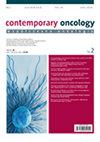单肾肿瘤部分体外切除后自体肾移植8年随访
IF 2.9
Q2 ONCOLOGY
引用次数: 1
摘要
根治性肾切除术(Radical nephrectomy, RN)仍然是治疗肾癌的“金标准”,但保留技术(nephron sparing surgery, NSS),包括去核、部分肾切除术或离体切除,正变得越来越重要。这些技术可以取得更好的结果,并发症和死亡率低。离体切除是一种与根治性肾切除术相当的技术。多灶性癌症的风险从6.5%到28%不等,而当肿瘤直径不超过4厘米时,多灶性癌症的风险降至5%。NSS的主要风险是同侧肾脏复发的可能性。复发率在0 - 10%之间,当肿瘤具有低恶性潜能且直径不超过4cm时复发率最低。有时,由于缺乏另一个肾脏,这是唯一的机会,允许保留功能的剩余肾脏。这篇论文描述了一个单肾患者,受直径超过5厘米的肿瘤影响,到达肾盂肾盂结构。由于肾盏浸润,采用离体技术,允许适当切除,肿瘤逻辑上足够的边缘和准确的尿路供应。手术技术和治疗的结果在极少数情况下,迄今为止描述讨论。本文章由计算机程序翻译,如有差异,请以英文原文为准。
8-year follow-up after partial ex vivo resection of tumour in a single kidney followed by autotransplantation
Radical nephrectomy (RN) in the treat ment of renal cell carcinoma remains the “gold standard”, but sparing tech niques (nephron sparing surgery, NSS), consisting of enucleation, partial nephrectomy or ex vivo resection, are increasingly gaining in importance. The techniques allow the achievement of better results, with a low rate of com plications and mortality. Ex vivo resec tion is a technique which is becoming equivalent to radical nephrectomy. The risk of multifocal cancer ranges from 6.5 to 28%, whereas when the tumour has a diameter not exceeding 4 cm, the risk of multiplicity drops to 5%. The main risk involved in NSS is the possibility of recurrence in the ipsilateral kidney. The incidence of recurrence ranges between 0 and 10% and it is the lowest when the tumour has a low malignant potential and does not exceed 4 cm in diameter. Sometimes, due to the lack of the oth er kidney, this is the only opportunity that allows preservation of function of the remaining kidney. The paper describes a patient with a single kidney, affected by a tumour with a diameter of more than 5 cm, reaching the pyelocalyceal structure. Due to infiltration of the renal calyx, the ex vivo technique was adopted, allow ing appropriate resection with an onco logically adequate margin and accurate supply of the urinary tract. The tech nique of surgery and the outcome of treatment in the very few cases described so far are discussed.
求助全文
通过发布文献求助,成功后即可免费获取论文全文。
去求助
来源期刊
CiteScore
3.10
自引率
0.00%
发文量
22
审稿时长
4-8 weeks
期刊介绍:
Contemporary Oncology is a journal aimed at oncologists, oncological surgeons, hematologists, radiologists, pathologists, radiotherapists, palliative care specialists, psychologists, nutritionists, and representatives of any other professions, whose interests are related to cancer. Manuscripts devoted to basic research in the field of oncology are also welcomed.

 求助内容:
求助内容: 应助结果提醒方式:
应助结果提醒方式:


